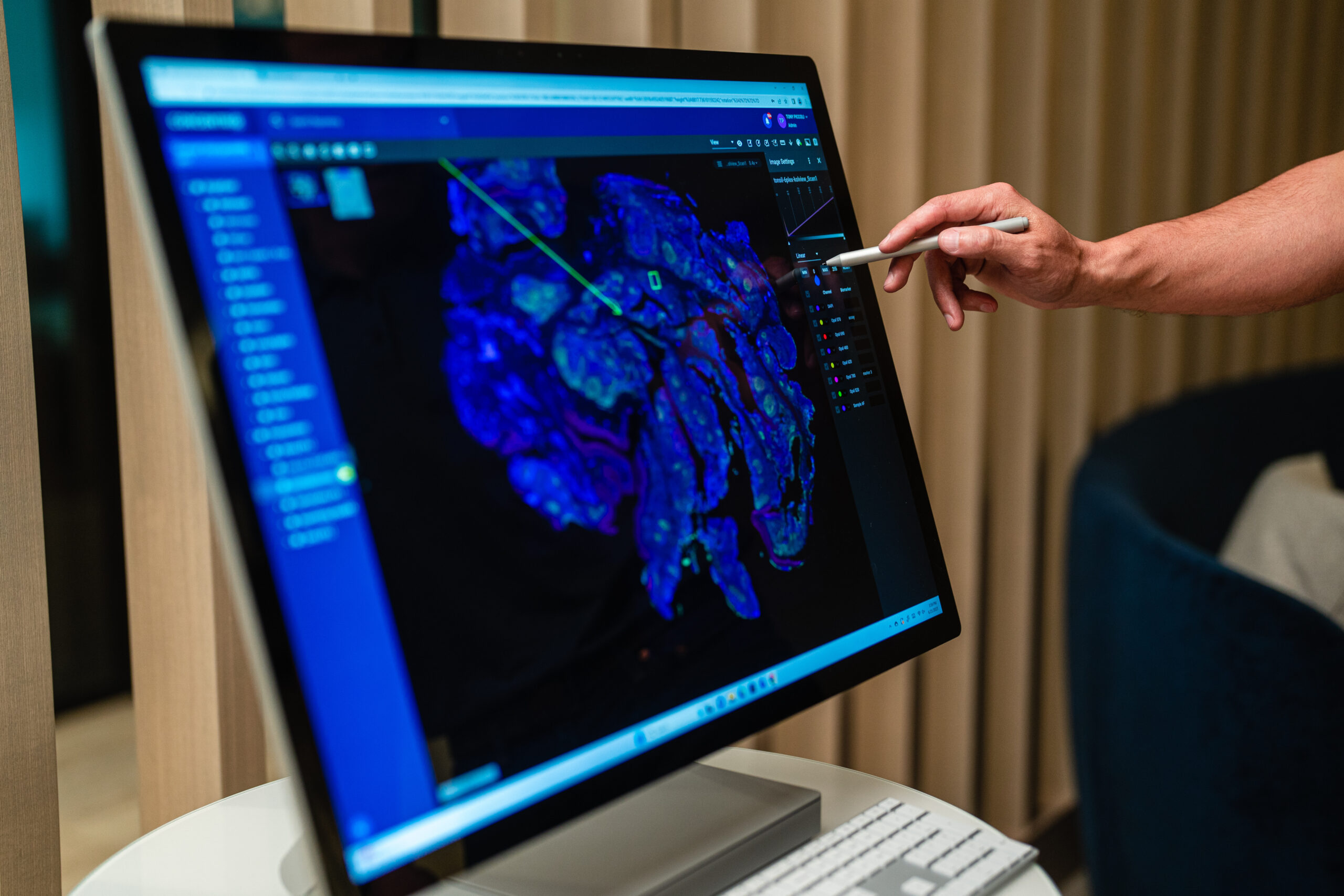As life sciences R&D teams increasingly leverage digital pathology and AI to accelerate their precision medicine programs, Proscia’s Concentriq LS platform is handling unprecedented volumes of high-resolution images, complex annotations, and collaborative workflows. With the latest release, our engineering team has made significant strides in performance.
I sat down with Taylor Tignino, Senior Software Engineer and Team Lead at Proscia, to discuss the technical innovations driving these improvements and why enterprise scalability matters now more than ever for life sciences organizations.
Ashley Faber: Concentriq LS has been generating excitement for its performance at scale. What specific architectural decisions have enabled the platform to scale effectively?
 Taylor Tignino: With the latest version of Concentriq LS, we’ve completely reimagined our core architecture—front to back—to address the scaling challenges our enterprise customers face. On the backend, the most significant changes include rewriting our roles and permissions system to reduce its load on the platform and reworking image search endpoints. Now, searches return results much faster.
Taylor Tignino: With the latest version of Concentriq LS, we’ve completely reimagined our core architecture—front to back—to address the scaling challenges our enterprise customers face. On the backend, the most significant changes include rewriting our roles and permissions system to reduce its load on the platform and reworking image search endpoints. Now, searches return results much faster.
On the front end, we’ve migrated where our state is stored to drive performance gains. From there, we took a hard look at the performance of specific algorithms and improved them to process large amounts of data faster on the front end. We’ve also overhauled our annotation system to handle much larger volumes. Now, when analyzing slides with thousands of annotations—which is common in AI-assisted workflows—users are experiencing a smoother experience.
One metric from our testing that really stands out: when working with a large repository of 20,000 or 40,000 images, viewer loading times are approximately 80% faster* compared to the platform’s previous version. This directly translates to pathologists spending less time waiting and more time analyzing critical data.
And we not only enhanced the actual functionality in the system, but made process changes as well. Across the board, we’re leveraging AI to help us automate our testing and examine specific endpoints from the perspective of: “Now that we expect users to be working with 10,000 or more images at a time, how do we improve this experience?”
AF: Can you explain how strong performance impacts day-to-day work for pathologists and scientists using the platform?

TT: For pathologists, every second of waiting is time not spent on scientific analysis. The next breakthrough discovery does not have time to wait for an image repository to open or annotations to save.
One of our core tenets as a company is that pathologists deserve great technology. We recognize that our community of pathologists and scientists are on the frontlines advancing critical milestones to combat cancer and other devastating conditions. We need to earn our community’s respect by not only creating beautiful and compelling experiences that go above and beyond expectations, but by delivering outstanding performance — empowering pathologists to work at their best with confidence and efficiency day in and day out.
And from a human standpoint, no matter what you’re doing, it’s awful when you can’t perform your work efficiently. We’re constantly asking ourselves how we can enable users to work with increasingly complex datasets without performance concerns intruding on their process.
AF: When we talk about platform scalability, there are many elements to consider beyond high image volumes. There are annotations layered on those images and metadata associated with those images. Not to mention an increasing number of users and integrations performing analysis. Could you characterize how these different scaling factors put stress on the system and how our architecture handles that?
TT: Proscia started as a small startup where we didn’t have huge customers using the system at this scale. Over the last few years (Proscia’s growth more than doubled in 2024), we’re seeing what it looks like when customers are truly stressing our systems—and what a wonderful problem to have! We have customers who are loading our system with data and using it so frequently that they’re creating enormous amounts of data on top of it.
Our customers are also using our platform in new and different ways as AI has fundamentally redefined what’s possible in pathology. There’s a drastic increase in annotation volumes as data scientists are leveraging images to develop proprietary deep learning models to gain a deeper, more precise understanding of disease or accelerate workflows with cancer detection and other tools.
The more our customers have pushed the boundaries of pathology, the more we know what to expect (and how to prepare for the unexpected), and the more we’ve improved. I love that. They’re pushing us to continually better our system. Now, we have an incredible understanding of what a scaling system looks like and what we need to support our enterprise customers, who will only keep pushing us to improve. This release in particular has been our biggest push toward building a truly top-notch performant system and understanding how to keep improving.
AF: Leading a team through such extensive performance improvements must present unique challenges. What were the biggest obstacles you had to overcome?
TT: It takes an enormous effort to deliver these improvements. It’s a lot of technical maintenance, a lot of staring at code and tinkering with it until it works better. We touched hundreds of files in a single release, which is huge from both a development and QA perspective.
What really helped us rise above these challenges was a rigorous benchmarking process where we continuously measured performance against usage patterns from our largest customers. By identifying specific performance bottlenecks through actual customer usage metrics, we could focus our efforts precisely where they would deliver the most value for pathologists and data scientists. This data-driven approach also allowed us to test our work to ensure we were continuously making progress in real-world scenarios.
AF: Any final thoughts on what sets Concentriq LS apart in terms of enterprise scalability?
TT: While I can’t speak to other digital pathology systems, I can say that I’m extremely proud of how at Proscia, enterprise scalability isn’t an afterthought or add-on. It’s a central focus for our product and engineering teams.
As I mentioned before, it takes incredible commitment and hard work to ensure the platform scales. There’s a temptation for the organization to drop these efforts in favor of shiny new features. Those are important—we have to evolve the platform—but everyone at Proscia understands to the core that performance is fundamental.
Beyond the technical architecture, I’m particularly proud of how we’ve maintained focus on the end-user experience throughout this transformation. It’s easy to get caught up in backend optimizations and forget that performance ultimately matters because it affects human workflows. Architectural decisions are tested against real-world pathologist workflows to ensure they deliver tangible benefits.
The result is a platform that doesn’t just scale technically but scales gracefully. The intuitive experience and workflow efficiency that Concentriq LS is known for is preserved, even as it handles enterprise-level demands. For life sciences organizations making long-term strategic investments in digital pathology, I believe that combination of scalability and usability is the true differentiator.
The latest version of Concentriq LS is now available. Current Proscia customers can see a full list of improvements in our detailed release notes.
For more information on how these performance improvements can benefit your organization, schedule a personalized demo with a life sciences digital pathology expert.
*Based on internal testing by Proscia’s engineering team comparing Concentriq LS Version 4.3 to Version 4.2. Your results may vary.
Ashley Faber is the Director of Product Marketing at Proscia.
